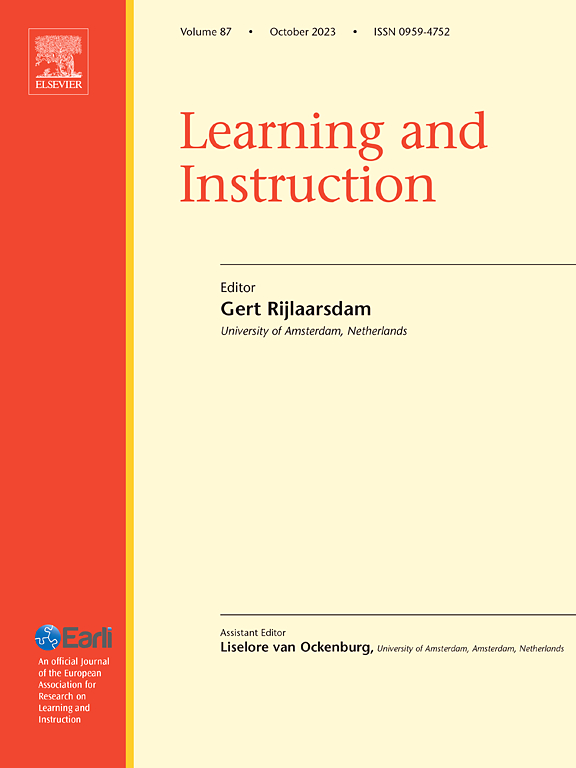How can scientific inquiry groups improve learning performance? ——Analysis based on the combination of NCA and fsQCA
IF 4.9
1区 教育学
Q1 EDUCATION & EDUCATIONAL RESEARCH
引用次数: 0
Abstract
Background
Collaborative problem-solving (CPS) ability is the core quality necessary for students' current study and future work. The performance of CPS in practical teaching contexts is affected by a combination of multiple factors. Revealing the mechanism of complex and diverse group characteristics on CPS level is a breakthrough in current research.
Aims
The paper intends to integrate structural, motivational, and interactive characteristics of groups to explore their synergistic pathways in influencing the effectiveness of CPS within groups.
Sample
Participants were 129 primary school students.
Methods
This study created guided problem-solving scenarios. Students worked in groups of 5–6, conducted two rounds of scientific inquiry activities, and completed a group worksheet and a reflective questionnaire.
Results
This paper found that the learning performance of scientific inquiry groups is the result of the synergistic effect of various group characteristics. Groups with high-quality performance demonstrate three driving patterns: high morale groups riven by high information interaction, heterogeneous groups driven by high motivation and information interaction, and heterogeneous groups driven by interpersonal interaction. Moreover, the characteristics of interpersonal interaction or information interaction are essential to achieve high-quality group performance. High-quality group performance can't be separated from the group characteristics of heterogeneity, learning motivation or self-efficacy.
Conclusions
For cultivating CPS skills., teachers should comprehensively consider multiple group characteristics and create favorable group conditions through group design. They should also promote collaborative communication through value guidance and rule establishment., and enhance the effectiveness of information interaction by designing external learning support, thereby improving group learning performance.
科学探究小组如何提高学习成绩?——基于NCA和fsQCA结合的分析
协作解决问题(CPS)能力是学生当前学习和未来工作所必需的核心素质。CPS在实际教学情境中的表现受到多种因素的综合影响。在CPS层面揭示群体特征复杂多样的机制是当前研究的一个突破。目的整合群体的结构特征、动机特征和互动特征,探索其协同影响群体内CPS有效性的途径。样本参与者为129名小学生。方法本研究创建了指导性问题解决方案。学生以5-6人为一组,进行了两轮科学探究活动,并完成了一份小组工作表和一份反思性问卷。结果科学探究群体的学习绩效是多种群体特征协同作用的结果。高质量绩效群体表现出三种驱动模式:高信息互动驱动的高士气群体、高动机和高信息互动驱动的异质群体和人际互动驱动的异质群体。此外,人际互动或信息互动的特征对于实现高质量的群体绩效至关重要。高质量的群体绩效离不开异质性、学习动机或自我效能感等群体特征。结论培养CPS技能。,教师应综合考虑多种群体特征,通过群体设计创造有利的群体条件。通过价值观引导和规则建立,促进协同沟通。,通过设计外部学习支持来增强信息交互的有效性,从而提高小组学习绩效。
本文章由计算机程序翻译,如有差异,请以英文原文为准。
求助全文
约1分钟内获得全文
求助全文
来源期刊

Learning and Instruction
Multiple-
CiteScore
11.30
自引率
4.80%
发文量
109
期刊介绍:
As an international, multi-disciplinary, peer-refereed journal, Learning and Instruction provides a platform for the publication of the most advanced scientific research in the areas of learning, development, instruction and teaching. The journal welcomes original empirical investigations. The papers may represent a variety of theoretical perspectives and different methodological approaches. They may refer to any age level, from infants to adults and to a diversity of learning and instructional settings, from laboratory experiments to field studies. The major criteria in the review and the selection process concern the significance of the contribution to the area of learning and instruction, and the rigor of the study.
 求助内容:
求助内容: 应助结果提醒方式:
应助结果提醒方式:


